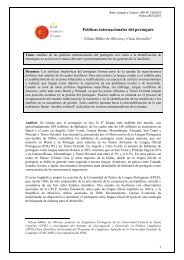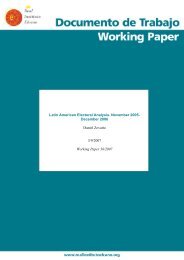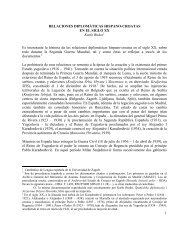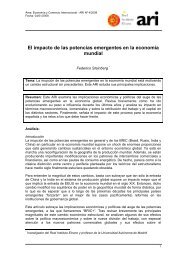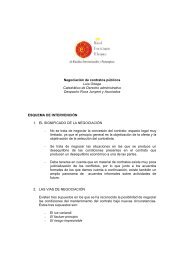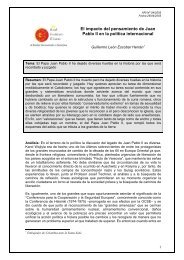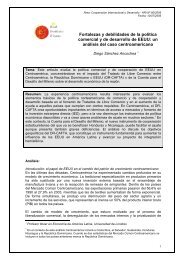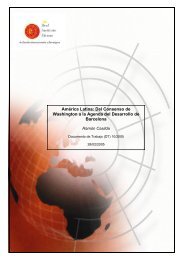Spain and the United States - Real Instituto Elcano
Spain and the United States - Real Instituto Elcano
Spain and the United States - Real Instituto Elcano
Create successful ePaper yourself
Turn your PDF publications into a flip-book with our unique Google optimized e-Paper software.
FOREIGN TRADE 83<br />
speaking, is to penetrate <strong>the</strong> domestic market <strong>and</strong> not to generate trade flows<br />
with <strong>the</strong> <strong>United</strong> <strong>States</strong>. 5<br />
Irel<strong>and</strong> is ano<strong>the</strong>r interesting example. Its market share of America’s<br />
foreign purchases rose almost fivefold from 0.4% in 1991 to 1.9% in 2004,<br />
making it <strong>the</strong> twelfth-largest supplier. This increase was largely <strong>the</strong> result of<br />
intra-company trade resulting from a big rise in Irish direct investment in <strong>the</strong><br />
<strong>United</strong> <strong>States</strong> <strong>and</strong> US investment in Irel<strong>and</strong>. <strong>Spain</strong>’s market share is just about<br />
holding steady; in order to increase it exports to <strong>the</strong> <strong>United</strong> <strong>States</strong> will have to<br />
grow at a much faster pace or a lot more direct investment will be needed.<br />
<strong>Spain</strong>’s exports to <strong>the</strong> <strong>United</strong> <strong>States</strong> grew by 12% in 2004, according to US<br />
figures, compared with 56% for Nigeria, 45% for Venezuela, 37% for Russia,<br />
22% for Belgium <strong>and</strong> 29% for China (which that year overtook Japan as <strong>the</strong><br />
world’s third-largest exporter).<br />
A commonly heard complaint about Spanish companies is that <strong>the</strong>y do not<br />
always have a sufficiently large stock to sell, so that when an importer places<br />
an order it cannot be filled. Some consumer goods companies only want to sell<br />
symbolic amounts in <strong>the</strong> <strong>United</strong> <strong>States</strong>, as this can help <strong>the</strong>m open doors into<br />
o<strong>the</strong>r much easier markets where <strong>the</strong> company can impress clients by saying<br />
that it sells to Saks Fifth Avenue or Neiman Marcus.<br />
This is <strong>the</strong> case, for example, with some wines, although Spanish wines are<br />
increasingly well rated by specialist publications in <strong>the</strong> <strong>United</strong> <strong>States</strong>, such as<br />
The Wine Spectator, <strong>the</strong> bible of <strong>the</strong> wine trade. Six of <strong>Spain</strong>’s wines were<br />
ranked among <strong>the</strong> world’s top 100 wines in 2004, <strong>and</strong> one of <strong>the</strong>m was in <strong>the</strong><br />
number three spot, <strong>the</strong> highest place so far achieved by a Spanish wine (see<br />
Exhibit 4.7). Also, Freixenet is <strong>the</strong> best-selling sparkling wine (cava) in <strong>the</strong><br />
<strong>United</strong> <strong>States</strong>. Exports of Spanish wines to <strong>the</strong> <strong>United</strong> <strong>States</strong> have been on an<br />
upward trend since 2000 (see Exhibit 4.8).<br />
The US market is a tough one to break into, but <strong>the</strong> rewards can be<br />
considerable. An example of this is Inoxcrom, which makes <strong>and</strong> distributes<br />
writing instruments. In 1996 Jordi Piqué, who had left Barcelona to work in<br />
Australia, where he boosted <strong>the</strong> company’s position from 78th to 4th place by<br />
sales volume, proposed that Inoxcrom study <strong>the</strong> potential of <strong>the</strong> US market.<br />
The results were encouraging, <strong>and</strong> Inoxcrom set up a subsidiary in New Jersey<br />
in 1997. In 2004, US-based Inoxcrom Inc generated sales of $25 million,<br />
almost half its worldwide sales.<br />
5. See “La Economía de Estado Unidos, El Sector Exterior y las Relaciones Comerciales Bilaterales” by<br />
Manuel Moreno Pinedo (Boletín Económico de ICE, 2839, March 21-April 3, 2005).



